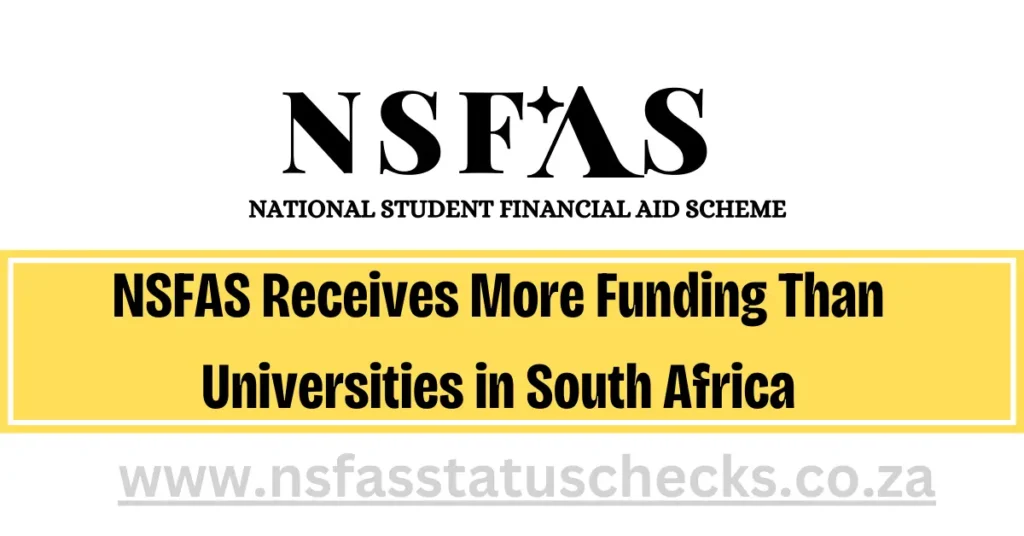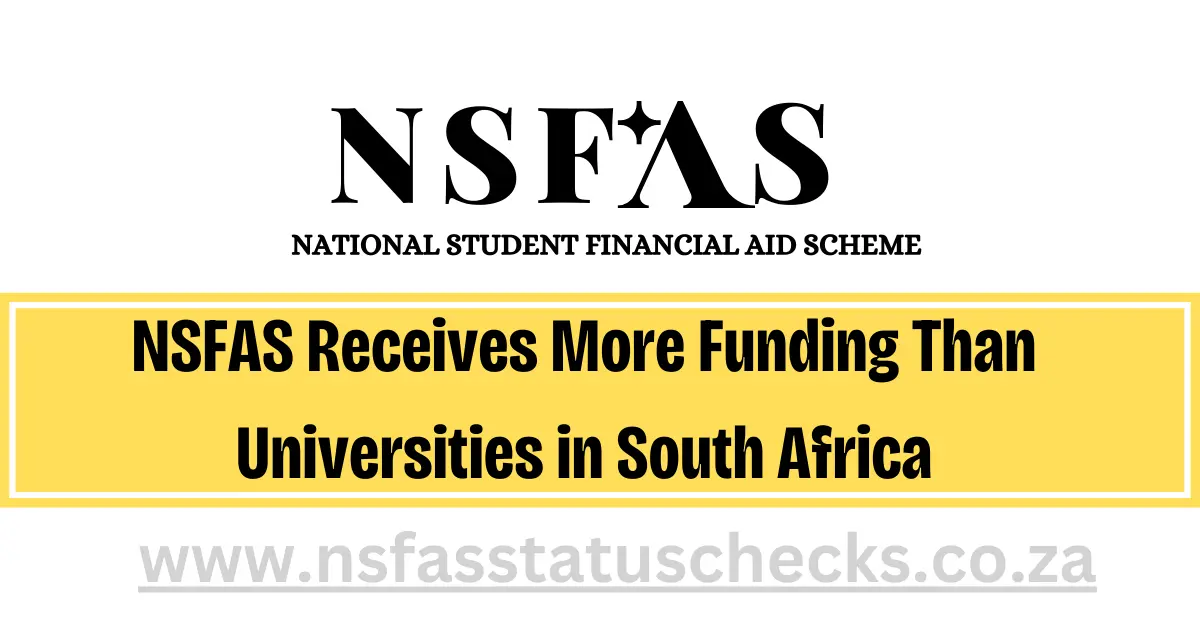In recent years, the National Student Financial Aid Scheme (NSFAS) has seen a significant increase in funding, surpassing the allocations received by universities in South Africa. This shift in financial dynamics has sparked discussions and debates about the implications for higher education institutions, students, and the broader community. In this article, we will delve into the intricacies of NSFAS funding, explore the challenges faced by universities, and examine the public’s reaction to this funding disparity.

Importance of NSFAS Funding
Supporting Underprivileged Students
In the support of economically disadvantaged students, NSFAS plays a crucial role. The increased funding allows for a broader reach, enabling more aspiring students to access higher education.
Enhancing Access to Higher Education
The NSFAS provides financial assistance to students to help them overcome barriers to education. This has a positive impact on the overall accessibility of higher education in South Africa.
Positive Impact on National Development
Education through NSFAS contributes to economic growth and national development by developing a skilled workforce.
Allocation Process of NSFAS Funds
Criteria for Student Eligibility
NSFAS has specific criteria for determining student eligibility, including income thresholds and academic performance. Financial assistance applicants must understand these criteria.
Application and Approval Procedure
The process of applying for NSFAS funding involves several steps, from submission of applications to the approval and disbursement of funds. Clear communication and guidance are crucial at each stage.
Monitoring and Evaluation Mechanisms
In order to ensure funds are utilized appropriately, NSFAS implements an effective monitoring and evaluation system. This includes tracking academic progress and maintaining transparency in the allocation process.
Challenges Faced by Universities
Limited Resources and Infrastructure
Universities face challenges in providing quality education due to limited resources.There is an additional layer of complexity with NSFAS due to the disparity in funding.
Impact on the Quality of Education
Insufficient funds can lead to compromised educational quality, affecting infrastructure, faculty, and student services. This, in turn, may hinder the overall learning experience.
Potential Consequences for Academic Staff and Students
Both students and academic staff may be affected by the financial strain on universities. This includes potential staff cuts, reduced research opportunities, and fewer resources for student support services.
Public Reaction and Perception
Differing Opinions on NSFAS Funding
Public opinion on NSFAS funding varies. While some appreciate the initiative for supporting underprivileged students, others express concerns about the impact on university resources and quality of education.
Media Coverage and Public Discourse
Perceptions of the public are greatly influenced by the media. The coverage of NSFAS funding changes influences public discourse and contributes to the ongoing dialogue about the role of education in society.
Social Media Trends and Discussions
NSFAS funding is discussed and influenced by social media platforms. The multifaceted nature of the conversation relies on hashtags, trends, and user-generated content.
Future Implications
Long-Term Effects on Education Quality
Understanding the long-term effects of NSFAS funding on education quality is essential. Balancing immediate financial support with sustainable educational growth is a critical consideration.
Potential Adjustments to NSFAS Policies
Continuous evaluation of NSFAS policies is necessary to address emerging challenges. Flexibility and adaptability in policy-making contribute to the scheme’s effectiveness.
Government’s Role in Balancing Allocations
The government plays a pivotal role in balancing allocations between NSFAS and universities. To ensure sustainable development, collaborative efforts are essential.
Burstiness in Funding
Explanation of Burstiness Concept
Funding fluctuations can be unpredictable and irregular. Understanding burstiness is crucial in managing the dynamic financial landscape of educational institutions.
Application to NSFAS Funding Fluctuations
NSFAS funding experiences burstiness, leading to sudden increases or decreases. This unpredictability poses challenges for universities in planning and resource allocation.
Addressing Concerns and Finding Solutions
Efforts to address burstiness involve strategic planning, risk mitigation, and collaborative discussions between NSFAS and universities. Finding solutions requires a balance between immediate needs and long-term sustainability.
Balancing Burstiness and Perplexity
Importance of Finding a Balance
NSFAS and universities must strike the right balance between burstiness and complexity. Striking this balance ensures that sudden fluctuations are manageable, and long-term plans remain viable.
Government’s Role in Stabilizing Funding
The government holds a key role in stabilizing funding dynamics. Establishing clear frameworks, regular evaluations, and fostering collaboration between NSFAS and universities contribute to a more stable financial environment.
Collaborative Efforts Between NSFAS and Universities
Collaboration is pivotal in addressing funding challenges. A transparent and open dialogue between NSFAS and universities fosters understanding, allowing for joint problem-solving and improved strategic planning.
Case Studies
Examining Specific Instances of Funding Allocation
Analyzing specific cases provides insights into the impact of funding decisions. Case studies highlight successes, challenges, and lessons learned, offering valuable knowledge for future funding strategies.
Lessons Learned from Successful Cases
Identifying and understanding successful cases provides a blueprint for effective funding models. Learning from these instances can inform policies that lead to positive outcomes for both NSFAS and universities.
Identifying Challenges and Proposing Solutions
Examining challenges faced in specific cases allows for targeted solutions. Proposing solutions tailored to the unique circumstances of each challenge contributes to a more resilient and adaptive education system.
Recommendations for Improvement
Stakeholder Involvement in Decision-Making
Diverse perspectives are taken into account when various stakeholders are involved in decision-making processes.This inclusivity contributes to more comprehensive and informed decisions regarding NSFAS funding.
Transparent Communication About Funding Changes
Clear and transparent communication about funding changes is crucial. This includes providing timely information to universities, students, and the public to mitigate uncertainties and foster trust.
Continuous Evaluation and Adaptation of Policies
Regular evaluation of NSFAS policies and their impact is necessary. Adapting policies based on the evolving educational landscape ensures that funding strategies remain effective and responsive to emerging challenges.
Engaging the Community
Involving the Public in the Education Funding Conversation
It is beneficial to engage the public in discussion about education funding in order to foster a sense of shared responsibility. Including diverse voices in the conversation enriches the understanding of the complexities involved.
Creating Awareness About NSFAS Initiatives
Raising awareness about NSFAS initiatives educates the public on the scheme’s objectives and impact. This awareness contributes to a more informed and supportive community.
Encouraging Public-Private Partnerships
Exploring public-private partnerships enhances the sustainability of education funding. Collaborative efforts between government, private entities, and the public can create a more robust financial support system.
Impact on Student Success
Examining the Correlation Between Funding and Student Outcomes
Analyzing how funding impacts student success provides valuable insights. Understanding this correlation allows for targeted interventions to enhance student support and outcomes.
Stories of Students Benefiting from NSFAS
Humanizing the impact of NSFAS funding is done by sharing successful student stories.These narratives inspire and highlight the positive changes brought about by accessible education.
Potential Improvements for Better Student Support
To ensure a holistic approach to education, student support services need to be improved.Enhancements in mentoring, counseling, and career guidance contribute to overall student success.
Government’s Role in Education
Ensuring a Balanced Distribution of Funds
The government’s responsibility extends to ensuring a fair and balanced distribution of funds. Striking a balance between supporting individual students through NSFAS and sustaining the broader education system is paramount.
Collaborative Efforts with Universities for Sustainable Growth
Collaboration between the government and universities is essential for sustainable growth. Joint efforts can lead to the development of policies that address both short-term needs and long-term educational objectives.
Future Commitments to Education in South Africa
Establishing clear commitments to the future of education in South Africa is crucial. Long-term planning and sustained investments in education lay the foundation for a prosperous and knowledgeable society.
Conclusion
The increased funding received by NSFAS compared to universities in South Africa has sparked important conversations about the dynamics of education financing. Striking a balance between burstiness and perplexity, fostering collaboration, and ensuring transparent communication are key elements in navigating these funding challenges. As South Africa looks towards the future, a collaborative and adaptive approach will be crucial in creating a sustainable and inclusive education system.
FAQs
Is NSFAS funding only for university students?
No, NSFAS provides financial assistance for students pursuing various levels of higher education, including universities, TVET colleges, and other accredited institutions.
How does NSFAS determine eligibility for funding?
Eligibility is based on various factors, including family income, academic performance, and citizenship status. Applicants must meet specific criteria outlined by NSFAS.
Can universities appeal for increased funding from NSFAS?
Universities can engage in discussions with NSFAS to address concerns and share perspectives. However, the final decision on funding allocations rests with NSFAS.
How often does NSFAS review its funding policies?
NSFAS conducts regular reviews of its policies to adapt to changing circumstances. Policy adjustments aim to enhance the effectiveness of financial assistance programs.
What role does the government play in educatio
The government plays a central role in providing financial support to educational initiatives. This includes funding through NSFAS and broader policies to ensure access to quality education for all.
